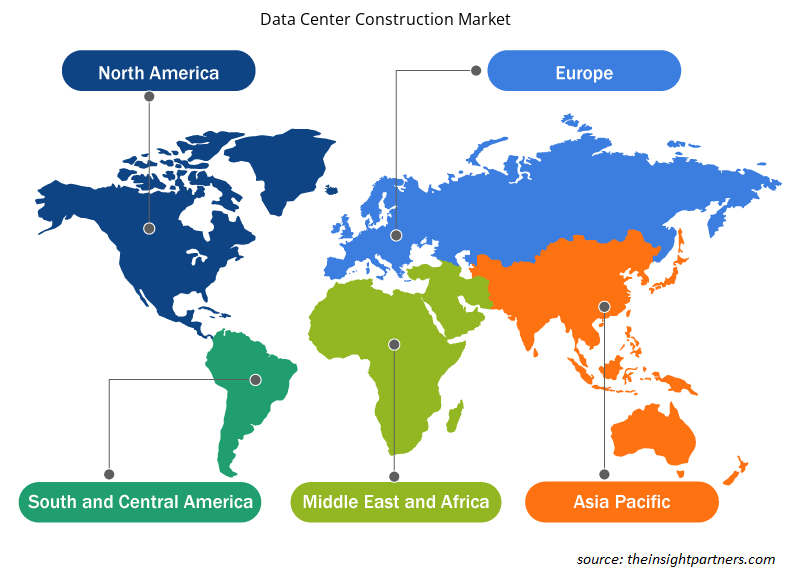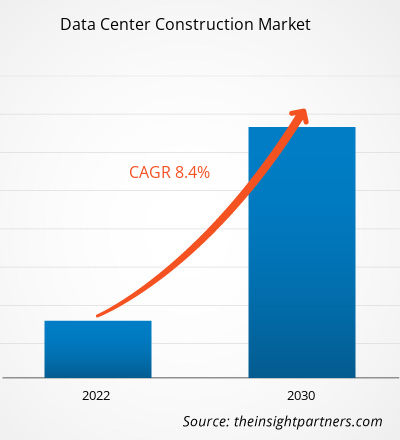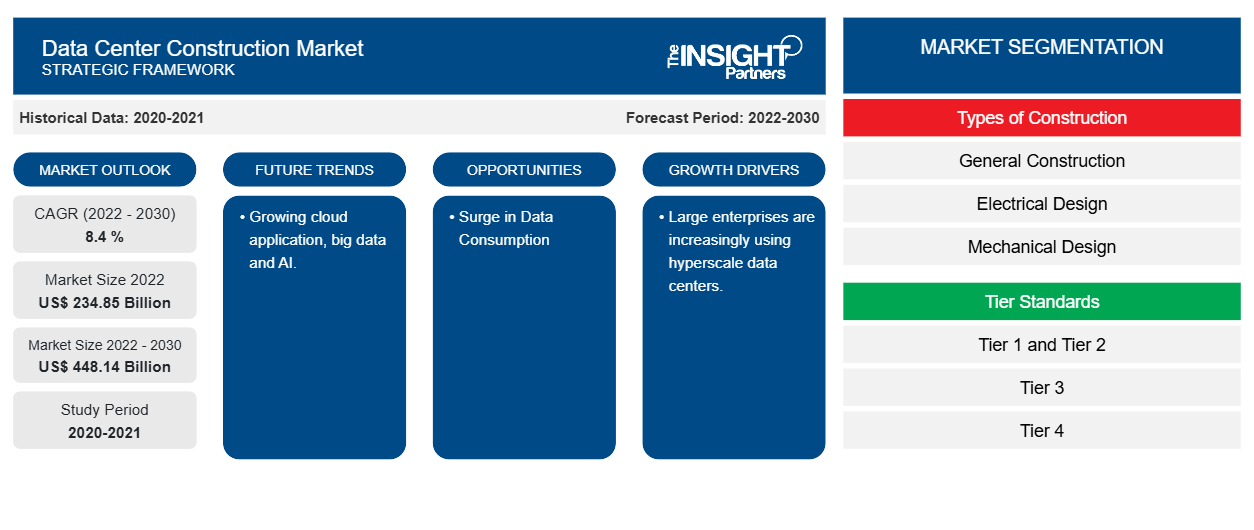من المتوقع أن يصل حجم سوق بناء مراكز البيانات إلى 448.14 مليار دولار أمريكي بحلول عام 2030 من 234.85 مليار دولار أمريكي في عام 2022. ومن المتوقع أن يسجل السوق معدل نمو سنوي مركب بنسبة 8.4٪ في الفترة 2022-2030. إن الطلب المتزايد على تخزين البيانات يدفع نمو السوق.
تحليل سوق بناء مراكز البيانات
يتوسع سوق بناء مراكز البيانات بسبب توسع صناعة تكنولوجيا المعلومات. يتم بناء مراكز البيانات بمجموعة متنوعة من التقنيات المبتكرة والجديدة. تشمل هذه التقنيات الذكاء الاصطناعي وتحليلات البيانات الضخمة وإنترنت الأشياء. طوال فترة التوقعات، سيعمل هذا العامل على دفع سوق بناء مراكز البيانات.
نظرة عامة على سوق بناء مراكز البيانات
من أجل تلبية الحاجة المتزايدة لمعالجة البيانات وتخزينها، تركز صناعة بناء مراكز البيانات العالمية على تنظيم وتطوير وبناء المباني المتخصصة التي تضم أنظمة الكمبيوتر والبنية الأساسية . تعد البنية الأساسية القوية لمركز البيانات ضرورية نظرًا للارتفاع في الحوسبة السحابية وتحليلات البيانات الضخمة والذكاء الاصطناعي وإنترنت الأشياء، والتي ساهمت جميعها في زيادة كبيرة في توليد البيانات. أدت الحاجة المتزايدة إلى الإدارة الفعالة لكميات هائلة من البيانات إلى توسع ملحوظ في هذه الصناعة.
قم بتخصيص هذا التقرير ليناسب متطلباتك
ستحصل على تخصيص لأي تقرير - مجانًا - بما في ذلك أجزاء من هذا التقرير، أو تحليل على مستوى الدولة، وحزمة بيانات Excel، بالإضافة إلى الاستفادة من العروض والخصومات الرائعة للشركات الناشئة والجامعات
-
احصل على أهم اتجاهات السوق الرئيسية لهذا التقرير.ستتضمن هذه العينة المجانية تحليلاً للبيانات، بدءًا من اتجاهات السوق وحتى التقديرات والتوقعات.
محركات وفرص سوق بناء مراكز البيانات
تستخدم الشركات الكبيرة بشكل متزايد مراكز البيانات الضخمة لصالح السوق
تُستخدم مراكز البيانات الضخمة في مجموعة متنوعة من الصناعات لتعزيز قوة الحوسبة والذاكرة والبنية الأساسية للشبكات وسعة التخزين. تتمتع مراكز البيانات الضخمة بالبنية الأساسية المادية وتقنيات التوزيع التي تساعدها على تعظيم كفاءة التبريد، فضلاً عن القدرة على توسيع نطاق أحمال عمل الحوسبة بكفاءة وعلى نطاق واسع. علاوة على ذلك، تنمو مبيعات أجهزة مركز البيانات وفقًا لمعايير Compute Project. تساهم OCP بشكل كبير في نمو السوق من خلال توفير حل تبريد متقدم لزيادة استهلاك الطاقة وكثافة الحوسبة بسرعة في مراكز البيانات من الجيل التالي دون أي تغييرات في المرافق الإضافية.
ارتفاع في استهلاك البيانات
مع حصول المزيد من الأشخاص على اتصال بالإنترنت، يزداد الطلب على الخدمات عبر الإنترنت والمواد الرقمية والتطبيقات المستندة إلى السحابة. وتتطلب هذه الزيادة في استهلاك البيانات نمو وإنشاء مراكز البيانات للتعامل مع الحجم المتزايد من المعلومات. وتأتي الفرصة في تلبية احتياجات الاتصال المتزايدة، مما يسمح للشركات بالاستفادة من الإمكانات الهائلة لسكان العالم المتصلين رقميًا. تلعب مراكز البيانات دورًا مهمًا في السماح بهذا الاتصال من خلال توفير البنية الأساسية اللازمة لمعالجة البيانات وتخزينها ونقلها بسلاسة وكفاءة. ونتيجة لذلك، تطور تطوير مراكز البيانات إلى استثمار استراتيجي لدعم والاستفادة من المشهد المتزايد للإنترنت .
تقرير تحليل تجزئة سوق بناء مراكز البيانات
إن القطاعات الرئيسية التي ساهمت في استخلاص تحليل سوق بناء مراكز البيانات هي أنواع البناء، ومعايير المستويات، والقطاعات الرأسية للصناعة.
- اعتمادًا على أنواع البناء، يتم تقسيم سوق بناء مراكز البيانات إلى بناء عام، وتصميم كهربائي، وتصميم ميكانيكي.
- وفقًا لمعايير المستوى، يتم تقسيم السوق إلى المستوى 1 والمستوى 2 والمستوى 3 والمستوى 4.
- من حيث القطاعات الصناعية، يتم تقسيم السوق إلى BFSI، والحكومة، والتعليم، والتصنيع، وتجارة التجزئة، والنقل، والإعلام والترفيه، وغيرها.BFSI, government, education, manufacturing, retail, transportation, media & entertainment, and others.
تحليل حصة سوق بناء مراكز البيانات حسب المنطقة الجغرافية
ينقسم النطاق الجغرافي لتقرير سوق بناء مراكز البيانات بشكل أساسي إلى خمس مناطق: أمريكا الشمالية، ومنطقة آسيا والمحيط الهادئ، وأوروبا، والشرق الأوسط وأفريقيا، وأمريكا الجنوبية/أمريكا الجنوبية والوسطى. تتمتع أمريكا الشمالية باقتصاد صحي، ومع البنية التحتية المتقدمة للشبكة، فهي محرك أساسي لنمو الصناعة. تهيمن الولايات المتحدة على السوق الإقليمية، مع العديد من مزودي الخدمات السحابية الرئيسيين مثل Amazon.com وGoogle Inc. وFacebook. تشارك هذه المنظمات في إنشاء مراكز بيانات عملاقة وقدرات تخزين ومعالجة بيانات موسعة، مما يوفر فرصًا سوقية هائلة.
رؤى إقليمية حول سوق بناء مراكز البيانات
لقد قام المحللون في Insight Partners بشرح الاتجاهات والعوامل الإقليمية المؤثرة على سوق إنشاء مراكز البيانات طوال فترة التوقعات بشكل شامل. يناقش هذا القسم أيضًا قطاعات سوق إنشاء مراكز البيانات والجغرافيا في جميع أنحاء أمريكا الشمالية وأوروبا ومنطقة آسيا والمحيط الهادئ والشرق الأوسط وأفريقيا وأمريكا الجنوبية والوسطى.

- احصل على البيانات الإقليمية المحددة لسوق بناء مراكز البيانات
نطاق تقرير سوق بناء مراكز البيانات
| سمة التقرير | تفاصيل |
|---|---|
| حجم السوق في عام 2022 | 234.85 مليار دولار أمريكي |
| حجم السوق بحلول عام 2030 | 448.14 مليار دولار أمريكي |
| معدل النمو السنوي المركب العالمي (2022 - 2030) | 8.4% |
| البيانات التاريخية | 2020-2021 |
| فترة التنبؤ | 2022-2030 |
| القطاعات المغطاة |
حسب أنواع البناء
|
| المناطق والدول المغطاة |
أمريكا الشمالية
|
| قادة السوق وملفات تعريف الشركات الرئيسية |
|
كثافة اللاعبين في سوق بناء مراكز البيانات: فهم تأثيرها على ديناميكيات الأعمال
يشهد سوق بناء مراكز البيانات نموًا سريعًا، مدفوعًا بالطلب المتزايد من المستخدم النهائي بسبب عوامل مثل تفضيلات المستهلكين المتطورة والتقدم التكنولوجي والوعي المتزايد بفوائد المنتج. ومع ارتفاع الطلب، تعمل الشركات على توسيع عروضها والابتكار لتلبية احتياجات المستهلكين والاستفادة من الاتجاهات الناشئة، مما يؤدي إلى زيادة نمو السوق.
تشير كثافة اللاعبين في السوق إلى توزيع الشركات أو المؤسسات العاملة في سوق أو صناعة معينة. وهي تشير إلى عدد المنافسين (اللاعبين في السوق) الموجودين في مساحة سوق معينة نسبة إلى حجمها أو قيمتها السوقية الإجمالية.
الشركات الرئيسية العاملة في سوق بناء مراكز البيانات هي:
- الصعود
- شركة أيسر
- شركة سيسكو سيستمز
- شركة ديل
- فوجيتسو
- شركة هيوليت باكارد لتطوير المشاريع
إخلاء المسؤولية : الشركات المذكورة أعلاه ليست مرتبة بأي ترتيب معين.

- احصل على نظرة عامة على أهم اللاعبين الرئيسيين في سوق بناء مراكز البيانات
أخبار سوق بناء مراكز البيانات والتطورات الأخيرة
يتم تقييم سوق بناء مراكز البيانات من خلال جمع البيانات النوعية والكمية بعد البحث الأولي والثانوي، والذي يتضمن منشورات الشركات المهمة وبيانات الجمعيات وقواعد البيانات. فيما يلي قائمة بالتطورات في السوق:
- في يناير 2023، حصلت شركة TSL على عقد لبناء مركز بيانات خاص بها في أوفنباخ كجزء من استثمار بقيمة 2 مليار دولار من قبل المستثمر العقاري الأمريكي Vantage في بناء مراكز البيانات في أوروبا. بعد المرحلة الأولية من التطوير، سيبلغ سعة مركز بيانات Vantage 16 ميجاوات. سيحتوي الحرم الجامعي على ثلاثة مراكز بيانات متعددة الطوابق بسعة قصوى لتكنولوجيا المعلومات تبلغ 55 ميجاوات من الكهرباء المقدرة وحجم إجمالي 60.000 متر مربع.
(المصدر: TSL، موقع الشركة، 2023)
- في أبريل 2023، أعلنت مايكروسوفت عن افتتاح مركزها السحابي الموثوق الجديد في بولندا، وهو الأول في وسط وشرق أوروبا. تتكون منطقة السحابة الخاصة بشركة مايكروسوفت بولندا من ثلاثة مواقع مادية بالقرب من وارسو، ولكل منها مركز بيانات واحد أو أكثر. وتضمن هذه المنطقة تخزين البيانات في منطقة قضائية تلبي أعلى مستويات الأمان والخصوصية والامتثال التنظيمي.
(المصدر: موقع شركة مايكروسوفت، 2023)
تقرير سوق بناء مراكز البيانات: التغطية والنتائج المتوقعة
يوفر تقرير "حجم سوق بناء مراكز البيانات والتوقعات (2023-2030)" تحليلاً مفصلاً للسوق يغطي المجالات التالية:
- حجم السوق والتوقعات على المستويات العالمية والإقليمية والوطنية لجميع قطاعات السوق الرئيسية التي يغطيها النطاق
- ديناميكيات السوق مثل المحركات والقيود والفرص الرئيسية
- الاتجاهات المستقبلية الرئيسية
- تحليل مفصل لقوى PEST/Porter الخمس وSWOT
- تحليل السوق العالمي والإقليمي الذي يغطي اتجاهات السوق الرئيسية واللاعبين الرئيسيين واللوائح والتطورات الأخيرة في السوق
- تحليل المشهد الصناعي والمنافسة الذي يغطي تركيز السوق، وتحليل خريطة الحرارة، واللاعبين البارزين، والتطورات الأخيرة
- ملفات تعريف الشركة التفصيلية
- التحليل التاريخي (سنتان)، سنة الأساس، التوقعات (7 سنوات) مع معدل النمو السنوي المركب
- تحليل PEST و SWOT
- حجم السوق والقيمة / الحجم - عالمي، إقليمي، بلد
- الصناعة والمنافسة
- مجموعة بيانات إكسل
التقارير الحديثة
تقارير ذات صلة
شهادات العملاء
سبب الشراء
- اتخاذ قرارات مدروسة
- فهم ديناميكيات السوق
- تحليل المنافسة
- رؤى العملاء
- توقعات السوق
- تخفيف المخاطر
- التخطيط الاستراتيجي
- مبررات الاستثمار
- تحديد الأسواق الناشئة
- تحسين استراتيجيات التسويق
- تعزيز الكفاءة التشغيلية
- مواكبة التوجهات التنظيمية























 احصل على عينة مجانية ل - سوق بناء مراكز البيانات
احصل على عينة مجانية ل - سوق بناء مراكز البيانات